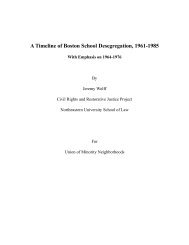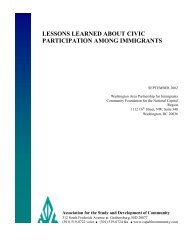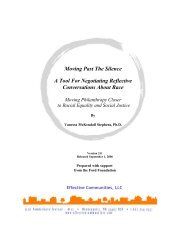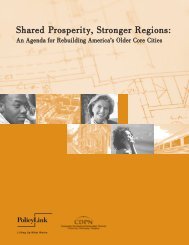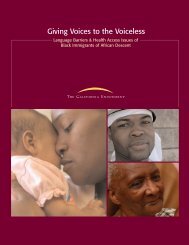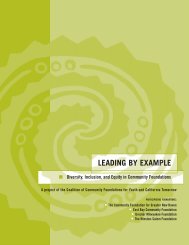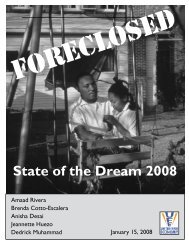EQUITABLE PUBLIC INVESTMENTLos AngelesThe 1999 completion <strong>of</strong> the Los Angeles sports <strong>and</strong>convention venue—the Staples Center—represents amajor <strong>and</strong> multi-dimensional success. Researchersfrom the University <strong>of</strong> California, Los Angeles, locallabor unions, <strong>and</strong> community residents all workedwith Strategic Actions for a Just Economy (SAJE),Los Angeles Alliance for a New Economy (LAANE),<strong>and</strong> Los Angeles’ Figueroa Corridor Coalition forEconomic Justice to craft a CBA that is nowconsidered a model for economic justice.The Los Angeles Alliance for a New Economy (LAANE) convenes aneighborhood demonstration covered by the local media. (Source: LAANE).Organized under the banner <strong>of</strong> the FigueroaCorridor Coalition for Economic Justice (convened<strong>and</strong> led by SAJE), neighborhood concerns forcongestion, child safety, <strong>and</strong> <strong>in</strong>creased crime led to aprecedent-sett<strong>in</strong>g CBA that <strong>in</strong>cluded:• A 20 percent set-aside for affordable hous<strong>in</strong>g;• 70 percent <strong>of</strong> new jobs guaranteed to <strong>of</strong>ferworkers livable wages;• Hir<strong>in</strong>g preferences that gave local <strong>and</strong> displacedresidents first opportunities for employment;• $1 million dedicated to community parks <strong>and</strong>recreation; <strong>and</strong>• Community <strong>in</strong>put on the project’s commercialtenants.Reflect<strong>in</strong>g on the Staples Center experience,executive director <strong>of</strong> LAANE, Madel<strong>in</strong>e Janis-Aparicio, observes, “We’re talk<strong>in</strong>g about chang<strong>in</strong>g theparadigm <strong>of</strong> economic development, chang<strong>in</strong>g thepower imbalance between the public <strong>and</strong> privatesectors.” The community’s successful role <strong>in</strong> theStaples Center CBA led to an even larger one,address<strong>in</strong>g expansion <strong>and</strong> modernization <strong>of</strong> the LosAngeles International Airport (LAX). An estimated$500 million CBA is attached to an $11 billionproject <strong>and</strong> will benefit low-<strong>in</strong>come communities <strong>of</strong>color located near the airport.On December 7, 2004, the Los Angeles CityCouncil approved—on a 14 to 1 vote—thedevelopment proposal <strong>and</strong> accompany<strong>in</strong>g CBA thatrequire:• A five-year, $25 million job tra<strong>in</strong><strong>in</strong>g programrequir<strong>in</strong>g the <strong>in</strong>volvement <strong>of</strong> every companydo<strong>in</strong>g bus<strong>in</strong>ess at the airport or as part <strong>of</strong> itsconstruction—effective on the date <strong>of</strong> localgovernmental adoption;• $200 million for local school improvements<strong>in</strong>clud<strong>in</strong>g emerg<strong>in</strong>g technologies <strong>and</strong> physicalimprovements such as w<strong>in</strong>dows <strong>and</strong> shelters;• Residential sound-pro<strong>of</strong><strong>in</strong>g for an estimated300,000 residents <strong>in</strong> surround<strong>in</strong>g neighborhoods;• An anti-tox<strong>in</strong> <strong>and</strong> green<strong>in</strong>g agenda that calls forgreen build<strong>in</strong>g practices, electrified gates tom<strong>in</strong>imize plane fumes, <strong>and</strong> the scheduled phaseout<strong>of</strong> diesel equipment;• A liv<strong>in</strong>g wage <strong>of</strong> at least $9.00 an hour plusbenefits <strong>of</strong>fered by all jobs generated by theproject; <strong>and</strong>• Tra<strong>in</strong><strong>in</strong>g for local community residents byparticipat<strong>in</strong>g build<strong>in</strong>g trades through theirapprentice programs.With the City Council’s passage, the approval processnow advances to the federal level. By July 2005,LAANE’s Janis-Aparicio anticipatesthe negotiatedagreements will takeeffect. Between theStaples <strong>and</strong> LAXagreements, thesecoalition efforts alsonegotiated five otherCBAs, impact<strong>in</strong>gapproximately 5,000jobs <strong>and</strong> creat<strong>in</strong>g hundreds <strong>of</strong> new affordablehous<strong>in</strong>g units.Milwaukee, Wis.“We’re talk<strong>in</strong>g aboutchang<strong>in</strong>g the paradigm <strong>of</strong>economic development,chang<strong>in</strong>g the powerimbalance between thepublic <strong>and</strong> private sectors.”— Madel<strong>in</strong>e Janis-AparicioWhile a major sports venue <strong>and</strong> airport expansiontriggered CBAs <strong>in</strong> Los Angeles, it was a newdowntown development project <strong>in</strong> Milwaukee, Wis.,that served as a catalyst for an alliance among poorpeople, faith-based organizations, unions, <strong>and</strong> public19Funders’ Network for Smart Growth <strong>and</strong> Livable Communities
policy advocates. In 2002, Milwaukee’s municipal<strong>of</strong>ficials were consider<strong>in</strong>g what would be the best newuse <strong>of</strong> a 60-acre tract <strong>of</strong> open l<strong>and</strong> result<strong>in</strong>g from thedemolition <strong>of</strong> the Park East Freeway on the northedge <strong>of</strong> downtown. Despite the lack <strong>of</strong> an exist<strong>in</strong>gorganization, related statistics, or detailed research,Milwaukee residents sensed an urgency to act.Accord<strong>in</strong>g to Dr. Kathleen Mulligan-Hansel,former director <strong>of</strong> the Work<strong>in</strong>g Families Project atthe Institute for Wiscons<strong>in</strong>’s Future, <strong>in</strong> the earlyadvocacy days, “The hard part was keep<strong>in</strong>g ustogether.” That alliance became the MilwaukeeGood Jobs <strong>and</strong> Livable Neighborhoods Coalition,comprised <strong>of</strong> 29 metro organizations push<strong>in</strong>gfor downtown redevelopment with anaccompany<strong>in</strong>g CBA.After an 18-month effort to advance the group’sCBA, on a 9 to 6 vote <strong>in</strong> June 2004, Milwaukee’sCommon Council rejected the suggested reforms. Atthe heart <strong>of</strong> the controversy were measures to addprevail<strong>in</strong>g wage st<strong>and</strong>ards <strong>and</strong> affordable hous<strong>in</strong>gthresholds to city-subsidized projects. Opponentssuccessfully argued to “let the marketplace decide.”As a result, the Milwaukee Council’s action limitedprevail<strong>in</strong>g wage requirements to contractors with atleast a $500,000 city subsidy. Surpris<strong>in</strong>gly, before theCouncil’s vote, many m<strong>in</strong>ority bus<strong>in</strong>esses expressedconcerns that by impos<strong>in</strong>g prevail<strong>in</strong>g wages, theiroperations would suffer.Reflect<strong>in</strong>g on the experience, Mulligan-Hansel, theCoalition’s co-chair observes, “We tried to w<strong>in</strong>agreement <strong>in</strong> a broad public policy overture. Wemight have won if that agreement goal had been withonly a developer.” Defeated but not discouraged ordisb<strong>and</strong>ed, the Coalition shifted its advocacy effortstowards ga<strong>in</strong><strong>in</strong>g support for their CBA from thecounty, because Milwaukee County held title to aportion <strong>of</strong> the acreage.On October 28, 2004, 11 members <strong>of</strong> MilwaukeeCounty’s Board <strong>of</strong> Supervisors <strong>in</strong>troduced aresolution endors<strong>in</strong>g the CBA. By the time themeasure came to a vote on December 16, 2004, ithad ga<strong>in</strong>ed both support <strong>and</strong> public attention. Beforea st<strong>and</strong><strong>in</strong>g-room-only audience, the resolution passedon a 15 to 4 vote. Follow<strong>in</strong>g the vote, Mulligan-Hansel celebrated, “This is a major victory forresidents <strong>in</strong> the city who need good jobs <strong>and</strong>hous<strong>in</strong>g.” Rev. Joseph Jackson, pastor <strong>of</strong> EvergreenBaptist Church <strong>and</strong> president <strong>of</strong> MilwaukeeInnercity Congregations Allied for Hope (MICAH),the Coalition’s faith-based partner, added, “We haveset a st<strong>and</strong>ard for all development <strong>in</strong> the city <strong>and</strong> thisst<strong>and</strong>ard will benefit the entire Milwaukeecommunity <strong>in</strong> the long run.” Although theCoalition’s celebratory mood proved premature whenMilwaukee County’s Executive vetoed the action onJanuary 7, 2005, less than a month later, on February3, 2005, the Milwaukee County Board <strong>of</strong>Supervisors overrode that veto with a second <strong>and</strong>f<strong>in</strong>al 15 to 4 vote.SeattleIn Seattle, named by Forbes magaz<strong>in</strong>e as the nation’sleast affordable city <strong>in</strong> 2004, the Seattle Alliance forGood Jobs <strong>and</strong> Hous<strong>in</strong>g for Everyone (SAGE) hasbeen work<strong>in</strong>g s<strong>in</strong>ce 2000 to better support Seattle’slow-wage workers. A strategic, broad-basedpartnership <strong>of</strong> labor <strong>and</strong> community organizations,SAGE heavily focuses on improved work<strong>in</strong>g <strong>and</strong>liv<strong>in</strong>g conditions.Through early <strong>and</strong> successful advocacy, SAGE wonpublic policy victories before form<strong>in</strong>g the Coalitionfor Healthy Communities <strong>in</strong> 2003. Affordablehous<strong>in</strong>g advocates, environmental groups, low-wageunion workers, all came together to underst<strong>and</strong> theircollective stake <strong>in</strong> redevelopment plans.In the spr<strong>in</strong>g 2004, SAGE began negotiat<strong>in</strong>g a CBAwith Vulcan, Inc., a Seattle developer. Vulcan’sproposed South Lake Union Development Projectsought to transform an area dom<strong>in</strong>ated by mar<strong>in</strong>ebasedbus<strong>in</strong>esses, warehous<strong>in</strong>g, light manufactur<strong>in</strong>g,<strong>and</strong> low-<strong>in</strong>come hous<strong>in</strong>g <strong>in</strong>to a biotech park. Asenvisioned, the project would also require substantialpublic support on <strong>in</strong>frastructure <strong>in</strong>vestments <strong>and</strong>zon<strong>in</strong>g modifications. The SAGE alliance identifiedits goals <strong>of</strong> ensur<strong>in</strong>g:• Livable wage jobs;• Transportation choices—advocat<strong>in</strong>g a mix <strong>of</strong>public transit, bicycle paths, <strong>and</strong> pedestrianwalkways;• Improved environment <strong>and</strong> susta<strong>in</strong>ability—parkspaces <strong>and</strong> upgrad<strong>in</strong>g <strong>of</strong> recreational amenities,green build<strong>in</strong>gs, <strong>and</strong> reduced energy dem<strong>and</strong>through better <strong>in</strong>sulation <strong>and</strong>/or construction;• A hous<strong>in</strong>g preservation strategy that would mixold <strong>and</strong> new dwell<strong>in</strong>gs with particular emphasisto the usable life <strong>of</strong> build<strong>in</strong>gs with historicsignificance; <strong>and</strong>EQUITABLE PUBLIC INVESTMENTPart III: Section 1: Promot<strong>in</strong>g Equitable Public Investment 20
- Page 1 and 2: Stories of Philanthropic Leadership
- Page 3 and 4: Signs of Promise:Stories of Philant
- Page 5 and 6: Funders’ Network for Smart Growth
- Page 7 and 8: (II. B.)(II. C.)Turning Neighborhoo
- Page 9 and 10: PART I:IntroductionThe Purpose of t
- Page 11 and 12: social justice issues as they relat
- Page 13 and 14: PART II:Perspectives on Advancing R
- Page 15 and 16: peer work, we can reestablish a sig
- Page 17 and 18: Annie E. Casey FoundationBaltimore,
- Page 19 and 20: neighborhoods into healthy ones—g
- Page 21 and 22: Charles and Helen Schwab Foundation
- Page 23 and 24: Section 1:Promoting Equitable Publi
- Page 25: I. A. BUILDING POWER AND GIVINGVOIC
- Page 29 and 30: in Los Angeles, Ford’s Anthony no
- Page 31 and 32: I. B. PROMOTING COALITIONSTO ADVANC
- Page 33 and 34: Yet the interpersonal dynamics of c
- Page 35 and 36: guidelines. “Many of the member o
- Page 37 and 38: Funder InterestThe EPA supported th
- Page 39 and 40: I. D. DEMONSTRATING THESTRUGGLE FOR
- Page 41 and 42: Richmond, Calif.The second regional
- Page 43 and 44: through policy reform at the local
- Page 45 and 46: I. E. BUILDING COALITIONTHROUGH KNO
- Page 47 and 48: organizing project, the Connecticut
- Page 49 and 50: and businesses are quantified in a
- Page 51 and 52: I. G. REVITALIZING WHILEASSURING DI
- Page 53 and 54: In the late 1990s, the city of Albu
- Page 55 and 56: I. H. A TRAVEZ DE LA FRONTERA:LAND
- Page 57 and 58: The International Community Foundat
- Page 59 and 60: I. I. MOBILIZING ACTION FORREGIONAL
- Page 61 and 62: To meet all of these objectives, th
- Page 63 and 64: efforts. And with each public plann
- Page 65 and 66: pattern of disproportionate transpo
- Page 67 and 68: Clinica de la Raza identify this cr
- Page 69 and 70: Contact PeopleCarl AnthonyActing Di
- Page 71 and 72: Section 2:Making All Neighborhoods
- Page 73 and 74: II. A. REACHING BEYONDHOUSING TO IM
- Page 75 and 76: A local resident receives the keys
- Page 77 and 78:
East Baltimore community and the Jo
- Page 79 and 80:
example, adjacent to the EBDI area,
- Page 81 and 82:
II. C. YIELDING REGIONALBENEFITS TH
- Page 83 and 84:
is using transit-oriented developme
- Page 85 and 86:
financing and innovative, forward-t
- Page 87 and 88:
The Row House Community Development
- Page 89 and 90:
II. E. COUNTERING THE PERFECTSTORM:
- Page 91 and 92:
funded community programs, includin
- Page 93 and 94:
housing developments and commercial
- Page 95 and 96:
owned enterprises, totaling $8.5 mi
- Page 97 and 98:
LOAN GUARANTEESSection 3:Connecting
- Page 99 and 100:
III. A. MAKING HOUSING ANOPPORTUNIT
- Page 101 and 102:
A new report from the National Hous
- Page 103 and 104:
The Straphangers Campaign was found
- Page 105 and 106:
Funder InterestThe Straphangers Cam
- Page 107 and 108:
or increase poverty. Whether direct
- Page 109 and 110:
The Regional Plan Association then
- Page 111 and 112:
multi-stakeholder effort composed o
- Page 113 and 114:
director with LISC. No one set of s
- Page 115 and 116:
12 western Louisville neighborhoods
- Page 117 and 118:
III. E. UNITING THREE STATESFOR ONE
- Page 119 and 120:
increased their personal wealth by
- Page 121 and 122:
summary evaluation of MSDI found th
- Page 123 and 124:
method alone was strong enough to m
- Page 125 and 126:
consistent body of work. The Counci
- Page 127 and 128:
3) Issues Need to be ConnectedThe f
- Page 129 and 130:
PART V:Glossary of TermsThe terms d
- Page 131 and 132:
Regional and neighborhood equity. A
- Page 133 and 134:
Tijuana River Reserve, California:h
- Page 135 and 136:
Sargent Shriver National Center on
- Page 137:
1500 San Remo Avenue • Suite 249



